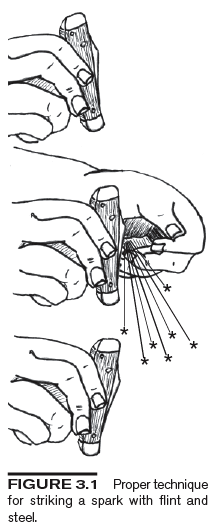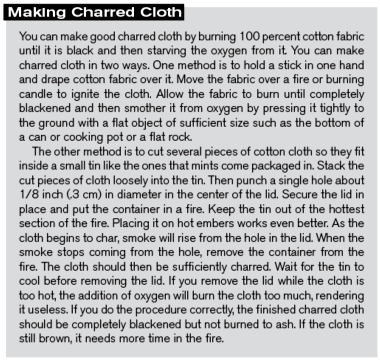How to start a fire using flint and steel
By Randy Gerke ©
 The flint and steel method of fire starting requires the use of steel in some form. The principle of this method is based on the interaction of two different materials by friction. Steel is struck against the sharp edge of a hard stone, and sparks form as the rock peels away tiny pieces of heated steel. The sparks are directed to the tinder bundle that has been prepared to accept them when they fall. The spark is then blown into flame. The disadvantage of this method is that steel is difficult to find in the wild.
The flint and steel method of fire starting requires the use of steel in some form. The principle of this method is based on the interaction of two different materials by friction. Steel is struck against the sharp edge of a hard stone, and sparks form as the rock peels away tiny pieces of heated steel. The sparks are directed to the tinder bundle that has been prepared to accept them when they fall. The spark is then blown into flame. The disadvantage of this method is that steel is difficult to find in the wild.
As indicated by the name, you need two items to start this type of fire: flint and a piece of steel. With some searching, you can find an appropriate piece of flint. Flint rocks, such as quartz, agate, chert, and jasper, which are high in silica content, are needed for striking fires. These stones have a smooth, glassy appearance. Stones that are easy to grasp in one hand are the ideal size. Smaller stones, which you can hold with your fingers, will also work, but they may be more difficult to use because you will need to hold the stone in a stationary position when creating a spark. You can strike a flint rock against another stone or other hard object to create sharp edges, which will enhance your ability to make good sparks with the stone.
High-carbon steel works best because it is soft and produces large sparks easily. Stainless steel is too hard and brittle to be effective. Pocketknife blades and steel files are two of the most common sources for the steel. Pocketknives made of high-carbon steel are typically less expensive than those made of stainless steel. Stainless steel blades usually have a stamp or engraving indicating that they are made of stainless steel. Steel files, available at hardware and building supply stores, work best when broken into pieces 4 to 5 inches (10 to 12 cm) in length.
For a flint and steel fire to be successful, you must use very fine, dry tinder. Sparks created in this manner are short lived and need to fall onto material that will capture and retain the small amount of heat generated. It is helpful to use charred powder, charred cloth, extra-fine steel wool, or some other spark-enhancing medium, which you place into the depression of the tinder bundle. These materials act as a vehicle to hold and spread the heat from the small steel spark. You can obtain charred powder by scraping the burned wood from an old campfire or forest fire, but charred cloth is a better spark-enhancing medium.
To strike a spark with flint and steel, follow these steps:
1. Kneel on the ground, place a tinder bundle in front of you, and crouch over the bundle. If you are using charred cloth, place a piece into the depression of the tinder bundle before you begin.
2. Hold the steel in one hand between your thumb and index finger. If you are using a pocketknife, hold the closed knife in the same fashion with the back of the knife blade facing the rock (see figure 3.1).
3. Grasp the flint in the opposite hand with the sharpest edge toward the steel.
4. To generate sparks, strike the steel against the sharp edge of the rock with a quick downward motion. Use deliberate, powerful strokes, directing the sparks toward the tinder bundle. Besides having the charred cloth in the tinder bundle, try holding a small piece under your thumb against the flint near the striking edge. Many times sparks will deflect upward away from the steel as it strikes the flint, and the cloth may catch them. Incorporating this technique can greatly increase your chances of catching a viable spark.
5. When you see a spark fall into the tinder, immediately give a light puff of air onto the tinder bundle. Alternatively, if you catch a good spark on the charred cloth under your thumb, quickly transfer it to the tinder bundle and blow it into flame. If the spark has begun to ignite the tinder, a small wisp of smoke will be present, and you should see a tiny glow in the bundle. Continue to blow the tinder into flame. If the tinder does not catch, continue striking sparks. In bright and sunny conditions, place the tinder bundle in the shade or position yourself so that you cast a shadow over the tinder. That way you can see where the sparks are falling and whether the tinder is beginning to burn.

